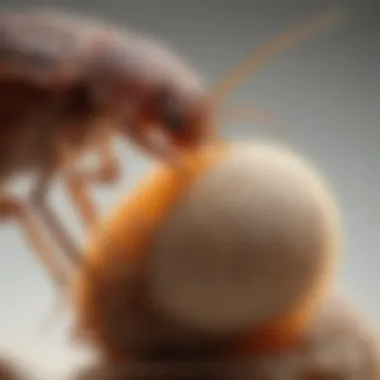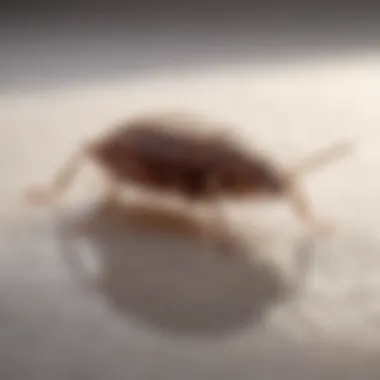Evaluating Foggers for Bed Bug Egg Elimination


Intro
Understanding Pests
Definition of Pests
Pests can be defined as organisms that adversely affect human activities, often leading to economic losses or health concerns. Bed bugs fall squarely within this definition. They thrive in domestic settings, feeding on human blood, and can multiply rapidly, leading to infestations. The need for efficient control methods like foggers arises from their ability to endure and proliferate in home environments.
Importance of Pest Identification
Accurate pest identification is crucial. It allows homeowners and professionals to choose the most effective strategies for elimination. Bed bugs, for instance, can easily be confused with other pests. By understanding their appearances and habitats, one can tailor their approach, whether it involves fogging or other techniques.
Prevention Techniques
Home and Garden Preventative Measures
Prevention is the first line of defense against bed bugs. Here are some key measures:
- Regular Cleaning: Frequent vacuuming can help eliminate any visible adults and eggs.
- Seal Cracks: Inspect and seal any gaps or cracks in walls and furniture.
- Monitor Luggage: Always check your bags after traveling to avoid bringing home unwanted guests.
- Limit Clutter: Reducing clutter reduces hiding places for bed bugs and makes treatment easier.
Seasonal Prevention Tips
Understanding seasonal changes can also aid in pest control. During warmer months, bed bug activity tends to increase. Homeowners should be especially vigilant while traveling or visiting crowded places like hotels.
Eco-Friendly Pest Control Solutions
Overview of Sustainable Practices
With growing awareness of environmental impacts, many homeowners are seeking sustainable practices in pest control. Using foggers can be part of this approach, especially when combined with eco-friendly chemicals that have less negative impact on the environment.
Natural Remedies and Their Effectiveness
In addition to chemical solutions, natural remedies may assist in reducing bed bug presence:
- Diatomaceous Earth: This natural powder can dry out bed bugs and their eggs upon contact.
- Essential Oils: Some oils have insecticidal properties, providing an alternative for those wary of chemicals.
"Understanding the biology and behavior of pests like bed bugs is essential for effective management."
Understanding Bed Bugs
Understanding bed bugs is essential for effectively tackling infestations. This section delves into critical elements related to the biology, life cycle, and reproductive patterns of bed bugs, providing a solid foundation for evaluating the effectiveness of any pest control method, including foggers. Knowing how bed bugs behave and reproduce helps homeowners and pest management professionals make informed decisions. This approach can lead to more effective pest management strategies and potentially save time and resources in the long run.
Biology of Bed Bugs
Bed bugs, scientifically known as Cimex lectularius, are small, wingless insects that feed on the blood of humans and animals. Adult bed bugs have a flat, reddish-brown body, measuring about 4 to 5 mm in length. Their flat bodies allow them to hide in tiny crevices, making them difficult to detect. Bed bugs are nocturnal, typically coming out at night to feed, which adds to their elusive nature.
Their mouthparts are specially adapted for piercing skin and sucking blood. They can survive long periods without feeding, making them resilient pests. New research shows that bed bugs can survive up to a year without a meal, depending on various factors. This adaptability is a significant reason why infestations can quickly spiral out of control.
Life Cycle of Bed Bugs


The life cycle of bed bugs consists of several stages: egg, nymph, and adult. Female bed bugs lay white, sticky eggs in clusters, often in hidden locations.
- Egg: The eggs are about 1 mm in size, resembling a grain of salt. They hatch in about 6 to 10 days, depending on temperature and humidity.
- Nymph: After hatching, bed bugs enter the nymph stage. They undergo five molts before reaching adulthood. Each nymph stage requires a blood meal for growth.
- Adult: Once they reach maturity, bed bugs can reproduce, continuing the cycle. Adults can live for several months to over a year, further complicating eradication efforts.
Reproductive Patterns
Reproductive patterns of bed bugs play a significant role in their persistence as pests. Female bed bugs can produce between one and five eggs per day after mating. Each female can lay around 500 eggs in her lifetime under optimal conditions.
- Mating Behavior: Bed bugs exhibit a unique mating behavior known as "traumatic insemination," where the male pierces the female's abdomen to deposit sperm.
- Synchronized Breeding: The timing of reproduction can be influenced by environmental factors such as temperature and availability of hosts.
The female bed bug’s ability to store sperm means that even a single mating event can lead to a substantial increase in the population. Recognizing these reproductive strategies can inform strategies for using foggers and other methods to manage infestations effectively.
Understanding the biology and life cycle of bed bugs can assist homeowners in identifying effective pest control measures, especially when foggers are a consideration.
In summary, a deeper comprehension of bed bugs lays the groundwork for assessing how foggers can impact their eggs and overall infestation control. This knowledge enables strategic planning and execution in pest management, ultimately leading to more successful outcomes.
Foggers in Pest Control
Foggers have emerged as a pivotal component in the realm of pest control, especially in the fight against stubborn infestations such as bed bugs. Their ability to deliver insecticides through aerosolized mist lends a unique advantage in reaching areas that traditional methods might miss. Understanding the relevance of foggers involves examining their operational mechanisms, types, and the specific chemicals they employ.
Definition and Function of Foggers
Foggers, fundamentally, are devices designed to disperse insecticides into the environment in a fine mist form. This process allows pesticides to coat surfaces, penetrate cracks, and crevices where pests reside. Foggers can treat larger areas compared to other spraying methods, making them a practical choice for homeowners facing a comprehensive bed bug problem. The efficiency of a fogger often boils down to how well it can encapsulate the intended space and deliver adequate payloads of insecticides.
Types of Foggers
Foggers can be categorized into various types, each serving specific needs and scenarios in pest control.
Cold Aerosol Foggers
Cold aerosol foggers produce a fine mist by vaporizing liquid insecticide at low temperatures. This is crucial for minimizing thermal breakdown of the chemicals, thus enhancing their effectiveness in killing pests. One notable characteristic of cold aerosol foggers is their ability to create a uniform distribution of particles. This method is popular because it allows even the toughest-to-reach areas to be targeted effectively. The advantage lies in its ease of use and safe application, as homeowners can activate the fogger without exposure to harmful fumes. However, it might require multiple applications in cases of heavy infestations, which can become time-consuming.
Thermal Foggers
Thermal foggers utilize heat to generate a dense fog of insecticide, making them particularly effective for treating open areas or deep infestations. The key characteristic of thermal foggers is their ability to produce a substantial amount of fog quickly, which can effectively penetrate furniture gaps and carpet fibers. For extensive infestations, this can be a beneficial option as it can eliminate a larger number of bed bugs in a single go. The drawback, though, is that the heat may degrade some chemicals, potentially reducing their efficacy.
Ultrasonic Foggers
Ultrasonic foggers represent a newer technology in pest control. They produce ultrasonic vibrations that create fine droplets of insecticide. One defining feature of this type is its ability to distribute many small particles with minimal noise, appealing to homeowners concerned about sound pollution. Ultrasonic foggers can be particularly effective in contained environments, as they can generate a persistent mist for extended periods. However, their efficiency against bed bug eggs specifically may not yet be thoroughly studied, making their practical application less common in direct comparisons with cold aerosol and thermal options.
Chemicals Used in Foggers
The effectiveness of foggers is largely determined by the chemicals they utilize. Many foggers rely on pyrethroids, a group of synthetic chemicals that mimic natural insecticides. They are potent against a variety of pests, including bed bugs. Some formulations also include insect growth regulators (IGRs) that disrupt bed bug development. The right choice of chemical is essential, as it affects not only efficiency in killing individuals but also in preventing new eggs from maturing.
Efficacy of Foggers Against Bed Bug Eggs
Foggers have become popular tools due to their ability to disperse insecticide over a wide area, ensuring coverage in places where bed bugs often hide. The benefits of using foggers include ease of application and the ability to reach difficult spaces. However, it is essential to understand the specific mechanisms of action, the outcomes of scientific research, and the inherent limitations in effectiveness to maximize their utility.
Mechanism of Action
Foggers work by creating a mist that disperses insecticidal chemicals in the air. These chemicals target various life stages of bed bugs, including eggs. The tiny droplets reach cracks and crevices, areas where bed bugs typically reside. When the fog comprises insect growth regulators or adulticides, it interrupts the bed bug life cycle.


Understanding the mechanic of foggers is vital because not all chemicals behave the same way. Some may kill adults but have less effect on eggs. Therefore, knowing the active ingredient in a fogger and how it interacts with bed bug eggs informs effective treatment strategies.
Research Findings
Laboratory Studies
Laboratory studies have provided valuable insights into foggers' efficacy against bed bug eggs. These studies often involve controlled conditions where researchers can precisely measure the impact of different fogging agents. One key characteristic of laboratory studies is their ability to eliminate outside variables, allowing for a focused examination of how foggers affect bed bug eggs. The significant benefit of this approach lies in determining the minimum exposure time needed to achieve effectiveness.
However, these studies come with limitations. They may not fully replicate real-world conditions, where factors like surface texture, insect behavior, and environmental response can change outcomes. Moreover, laboratory settings may use higher concentrations of insecticides than found in consumer-grade products, potentially skewing results.
Field Studies
Field studies look at the performance of foggers in actual residential settings. They take into account various factors that affect efficacy in real-life situations. These studies provide insights into how well foggers can penetrate and distribute insecticide throughout an infested area. A notable characteristic of field studies is their practical application; they show how foggers perform under typical usage scenarios.
The unique feature of these studies includes diverse results depending on the home layout and levels of infestation. However, field studies also come with disadvantages, including inconsistencies in bed bug populations and environmental variables that can influence conclusions.
Limitations in Effectiveness
Despite their advantages, foggers have limitations in effectiveness against bed bug eggs.
- Incomplete Coverage: Foggers rely on aerosol dispersion, which may not reach all hiding spots due to poor airflow.
- Chemical Resistance: Bed bugs have shown resistance to certain chemicals, which may not affect their eggs as expected.
- Timing and Follow-Up Treatments: Depending on the life cycle stage of bed bugs, foggers may need to be part of an integrated pest management strategy, including follow-up treatments for comprehensive control.
Hence, understanding these limitations is critical when using foggers as a key component in combatting bed bug infestations.
Best Practices for Using Foggers
Using foggers can be an effective method for addressing bed bug eggs, but to maximize results, adhering to best practices is essential. These practices not only enhance the success rate of fogging treatments but also ensure safety and minimize potential disruptions in your home. This section focuses on preparation, safety considerations, and the importance of thorough post-fogging clean-up.
Preparation Before Fogging
Before commencing fogging, adequate preparation is critical. This step ensures not only your safety but also the efficacy of the insecticide.
- Clear the Area: Remove items from the treatment zone. This includes furniture, bedding, and personal belongings. Ensure that toys and pet items are also relocated. A clutter-free space allows for better penetration of the fog into potential hiding spots of bed bugs.
- Seal Food and Utensils: All food items should be stored securely. Cover or relocate utensils to prevent contamination from the chemicals used in fogging.
- Identify Infested Areas: Focus on where you suspect bed bugs to be. Common areas include seams of mattresses, under cushions, and cracks in the walls. This allows for targeted fogging.
Adequate preparation can significantly impact the overall effectiveness of the treatment.
Safety Precautions
Ensuring safe application of fogging agents is paramount. The chemicals used can pose risks to both humans and pets. Here are some key safety precautions to follow:
- Read Labels Carefully: Always review the fogger instructions and safety warnings provided by the manufacturer. This will inform you about waiting periods, re-entry times, and specific precautions.
- Use Protective Gear: Wear protective clothing, gloves, goggles, and a mask while using foggers. This will minimize exposure to harmful chemicals.
- Ventilation: Ensure good airflow in the treated area to reduce inhalation risks. Open windows and doors, if possible, to facilitate adequate ventilation.
"Safety should always be a priority when using pest control methods. Proper precautions can prevent unnecessary health risks."
Post-Fogging Clean-Up
After fogging, thorough clean-up is crucial for maintaining a healthy living environment.
- Wait Period: Follow the recommended time before re-entering the treated area as specified on the fogger's label. This is essential to allow chemicals to settle safely.
- Air Out the Space: Ventilate the area after the wait period. Open windows and run fans to help dissipate chemical residues.
- Clean Surfaces: Wipe down any surfaces that might have come into contact with the fog. Use a damp cloth to remove residues from countertops and furniture.
- Return Items Gradually: Before placing items back in, ensure the area is clean, dry, and free from chemical traces. Reintroduce items slowly to monitor for any adverse effects.


By following these best practices, homeowners can not only increase the efficacy of foggers against bed bug eggs but also create a safer living environment post-treatment.
Alternative Pest Control Strategies
Understanding alternative pest control strategies is essential when tackling persistent bed bug problems. While using foggers can be effective to some extent, there are various other approaches that might yield better results or complement the fogging process. Assessing these alternative methods helps homeowners recognize that pest control is multi-faceted. Each strategy has its unique set of benefits and considerations, making it necessary to evaluate them thoroughly.
Heat Treatment
Heat treatment is a widely regarded alternative known for its effectiveness against all life stages of bed bugs, including eggs. This method uses high temperatures to eliminate bed bugs by raising the room temperature to around 120°F or higher. This temperature is lethal to bed bugs. The primary advantage of heat treatment is that it does not involve harmful chemicals, making it safe for the occupants of the home.
Effectively executing a heat treatment requires specialized equipment and knowledge. Often, professionals carry out this process, ensuring even heat distribution. Homeowners must consider the condition of belongings and structures in the target area, as not all items can withstand high heat.
Insecticides and Sprays
When it comes to insecticides and sprays, multiple products are available that can treat bed bug infestations. These chemicals work by either directly killing the pests or interrupting their life cycle. Common insecticides include pyrethroids, neonicotinoids, and insect growth regulators.
Benefits of using sprays include:
- Convenience in application
- Immediate impact on visible bed bugs
- Accessibility of products for do-it-yourself treatments
However, caution is necessary. Some bed bugs have developed resistance to certain insecticides, which can diminish effectiveness. Homeowners should closely follow application guidelines to avoid health risks associated with improper use.
Integrated Pest Management Approaches
Integrated Pest Management (IPM) is a holistic approach that combines multiple strategies for effective pest control. This method includes monitoring, prevention, and targeted use of treatments. By using IPM, homeowners can minimize risks to health and the environment.
Key components of IPM include:
- Regular inspections: Monitor for signs of infestation.
- Sanitation practices: Keep living spaces clean and clutter-free to reduce hiding spots.
- Biological control: Introducing natural predators or parasites to the pest population.
- Education: Awareness of bed bug habits and behaviors, which can aid in prevention.
IPM does not always focus solely on extermination. Instead, it emphasizes long-term management through sustainable practices. By integrating multiple strategies, homeowners can enhance the effectiveness of controlling bed bugs and create a less favorable environment for their resurgence.
Using various pest control strategies not only increases chances of eradication but also supports overall health and environmental safety.
The Ends and Recommendations
Examining the use of foggers against bed bug eggs reveals several important insights that can aid both homeowners and pest management professionals. It is critical to examine these elements carefully, considering the nature of bed bugs and the various techniques available to combat them. This discussion will enhance understanding and facilitate more effective pest control strategies.
Summation of Key Findings
Through this article, a comprehensive review of foggers' effectiveness against bed bug eggs has been conducted, emphasizing the following key findings:
- Mechanism of Action: Foggers work by dispersing insecticides in fine droplets, which can reach hidden areas where bed bugs might reside. However, the efficacy is contingent on the type of insecticide used and its capacity to penetrate tough surfaces like mattresses and carpets.
- Research Findings: Both laboratory and field studies indicate that while foggers can eliminate some bed bugs, their impact on eggs is variable. Results show that some fogging agents do not saturate well enough to reach all viable eggs, leaving a potential for future infestations.
- Limitations in Effectiveness: While foggers can be part of a multifaceted approach to pest control, they should not be relied on solely. Bed bug eggs’ resilience presents a challenge, necessitating complementary treatments such as heat or direct insecticide applications.
Recommendations for Homeowners
For homeowners dealing with bed bug infestations, several recommendations can enhance the likelihood of successful eradication:
- Employ Integrated Pest Management (IPM): Rather than relying solely on foggers, utilize a combination of strategies. This includes heat treatments, targeted insecticides, and vacuuming to remove adults and eggs effectively.
- Follow Instruction Manuals: Always adhere to the manufacturer’s instructions when using foggers. This ensures proper application and maximizes efficiency.
- Conduct Thorough Inspections: Conduct regular inspections of your living space and address potential hiding spots for bed bugs, such as seams of mattresses and behind baseboards. Prevention is a critical aspect of pest management.
- Engage Professionals: If the situation escalates, do not hesitate to contact pest control professionals. Their experience can lead to more comprehensive and effective solutions tailored to your specific infestation.
Future Directions for Research
Research in the area of bed bug management continues to be essential. Below are directions that could improve understanding and efficacy:
- New Insecticides: Investigating novel insecticides specifically formulated for targeting bed bug eggs could yield promising results. Identifying compounds that penetrate egg shells effectively may provide a breakthrough in treatment options.
- Behavioral Studies: Understanding the behavior of bed bugs in response to different chemicals and environmental conditions can lead to improved pest control strategies.
- Combination Treatments: Research into the synergy of combining various pest management techniques may present more holistic solutions. Exploring heat treatments alongside fogging could provide an improved elimination rate against both adult bed bugs and their eggs.
"Effective bed bug control requires a multifaceted approach, as relying on one method alone is unlikely to yield lasting results."



